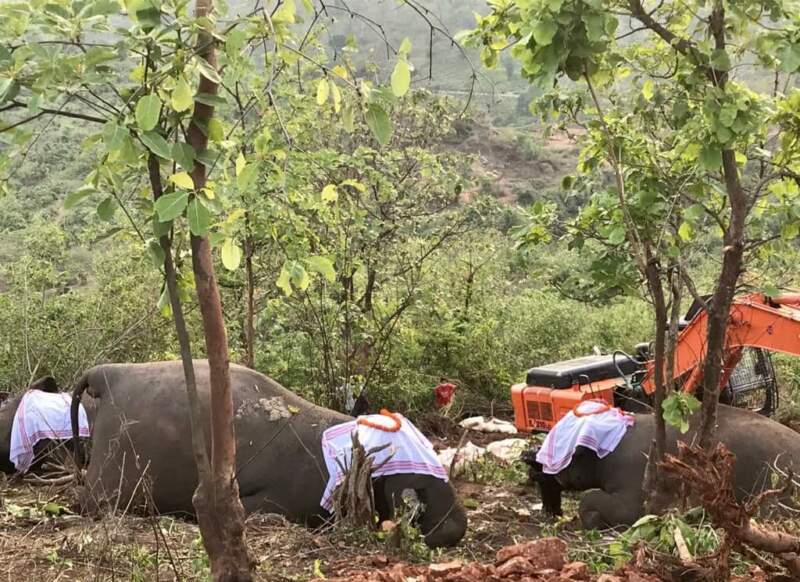Bamunipahar Hilltop Elephant Tragedy
Many questions remain unanswered by the Assam forest department over the mysterious elephant tragedy in which 18 wild Asiatic elephants died at Bamunipahar in Nagaon locality on 12 May. The local authority claimed the deaths in this elephant tragedy were a mystery. The Forest Department’s final report rested on the assumption, not scientific analysis, that the big animals died due to electrocution by a major thunderbolt.
State Forest Investigation Report
The investigation report was prepared by a government formed committee and released by State forest minister Parimal Suklabaidya during a formal press conference on 3 June in Guwahati.
After reviewing what they called “many loopholes” in the investigation report, environment enthusiasts insisted on a high level scientific probe into the incident to unearth the real cause of those shocking elephant deaths.
Some people in the community voiced their opinion that the deaths may have actually been planned murders.
Nature’s Beckon, an influential conservation group in northeast India, urged State chief minister Dr Himanta Biswa Sarma to initiate a proper investigation into the matter.
Soumyadeep Datta, a Nature’s Beckon director expressed serious doubts over the probing process. Mr. Datta insisted that experts from the fields of Geology, Electrical Engineering, Science of Lightning (Thundering) along with Zoological Survey of India, Wildlife Institute of India, Police department be included in the probe committee.
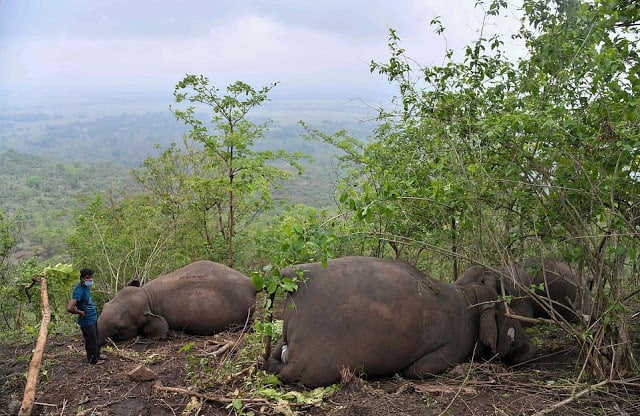
Dead elephants on hillside. Photo c/o Nava Thakuria.
The 90-page investigation report was released after repeated demands from various organisations and environment enthusiasts. Datta termed the report as “full of misinformation with a pile of unnecessary details added to make the document appear credible.”
The investigation process was revealed to only involve veterinarians directly or indirectly related to the forest department. In addition, all the tests were conducted in their own laboratories, allowing no access for independent test-centers.
Minister Suklabaidya, from the very beginning, asserted that all the elephants died after a massive thunderbolt hit. For obvious reasons, the departmental enquiry involved only two elephants for necessary dissections. As many as 16 animals were not forensically examined, according to Nature’s Beckon’s director, Soumyadeep Datta.
To prove that all the elephants died because of the electrocution by lightning, the ear-drums of the victims should have been examined. It was revealed that other organs sensitive to thunderbolt impact such as the hearts of every elephant were not thoroughly investigated.
The investigating committee mentioned that samples were collected randomly, but did not specify any carcass. Observers such as conservationist Bhaskar J Barua suspect this was an attempt to hide important evidence in the elephant tragedy.

two dead elephants. Photo c/o Nava Thakuria.
Barua, an engineering graduate and a member of Nature’s Beckon, asserted that the forest department’s report was “based on assumptions with no scientific analysis.”
“Nowhere does it say that lightning killed the elephants. Rather they assumed that lightning was the main culprit,” Barua said. He added that a leaked histopathology report also hinted at a tentative diagnosis of high voltage electrocution that killed the jumbos.
The single page histopathology report that started circulating since 24 May even inspired many so-called experts to conclude that the elephants were killed by a thunderbolt. Signed by professor SM Tamuli, Pathology department head and Pathology assistant professor A Deka (from College of Veterinary Science, Assam Agricultural University), the report came to the conclusion as a tentative diagnosis that lesions were suggestive of “high voltage electrical burn injury.”
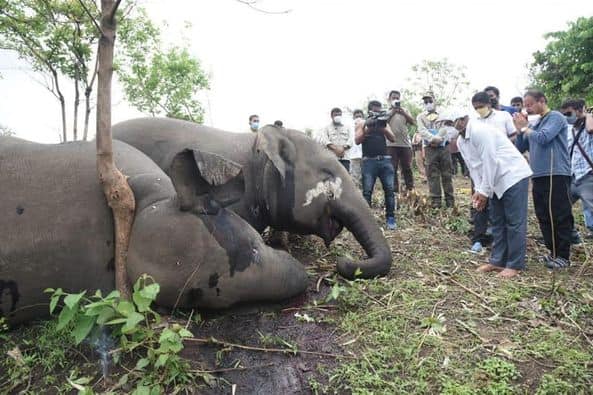
People investigating dead elephants. Photo c/o Nava Thakuria.
Hindu Mythology Reveres Elephants
Soon after the news broke on 13 May through various media outlets, sensations prevailed among the common people. Elephants are adored as a symbol of Lord Ganesh (also known as Ganapati and Vinayaka), the most worshipped son of Devi Parvati and Shiva Mahadev in Hindu mythology and many devotees of the neighborhood arrived at the remote location to pay their last respects to the dead. Later the elephants were buried with flowers at the same place as the customary ritual.
The issue received public attention with a sharp statement from All Assam Engineer’s Association (AAEA). The Association described the lightning argument as absurd. The forum of electrical, electronics, mechanical, etc, engineering graduates asserted that if such a massive thunderbolt had struck the Earth that night and killed all of the giant animals within a second, then gloomy days are ahead for the wildlife and human population.
The engineers’ forum argued that even if the victim animals were assumed to be very close to each other during the incident (to all be electrocuted at the same time), their carcasses should have been found together, but in reality it was found that their bodies were seen scattered by around 100 meters. On the other hand, if the animals faced the thunderstrike as they were found lying on the ground, it needed a massive strike covering over a thousand square-meter area oo the hillock.
Datta also had a pertinent question to ask, if the Bamunipahar area was an elephant habitat and a known animal corridor (as mentioned in the released report), how could the forest department provide a no-objection certificate to a giant solar power project coming into the locality. Moreover, Datta added, a group of local youths urged the minister during his visit to the site to check the matter seriously, but why did he not pay attention to them?
The solar power plant with the capacity of around 15 megaWatt at the foothills of Karbi Pahar recently received low-key responses from the media even after hundreds of marginal farmers in Mikir Bamuni grant village (under Samaguri revenue circle in Nagaon) protested against the Azure Power Forty Private Limited. That company allegedly grabbed their fertile land, cultivated by them for generations, for the project.
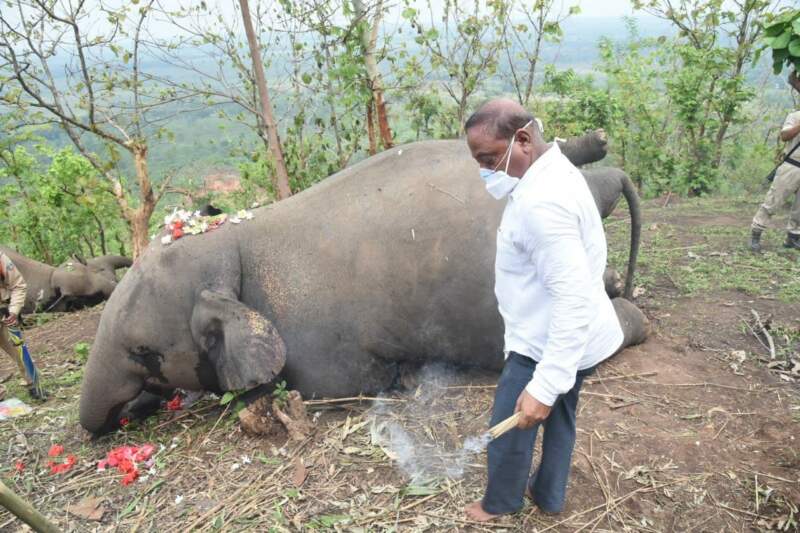
Man pays respect to dead elephant in Asom. Photo c/o Nava Thakuria.
For over a year, a group of Karbi and Adivasi villagers have been fighting for their land rights and many of the protesters were even put behind bars by the administration. The 400-million-dollar company claimed it bought the land from the erstwhile landlord’s (zamindar) family in August 2020. When India was facing the severe Covid-19 pandemic, the company also took possession of the land under police protection.
Now the matter has reached Gauhati High Court, where the highest court in the State on 1 March ordered status quo on the matter. Now the construction works of the power plant, put up in a campus of over 276 bighas of land by the company (claimed by the Saket-New Delhi based corporate office to be a dedicated solar power company with a journey spanning over a decade), has ceased.
The State forestry department may think this is the end of the matter, but this elephant tragedy will not be dismissed lightly.
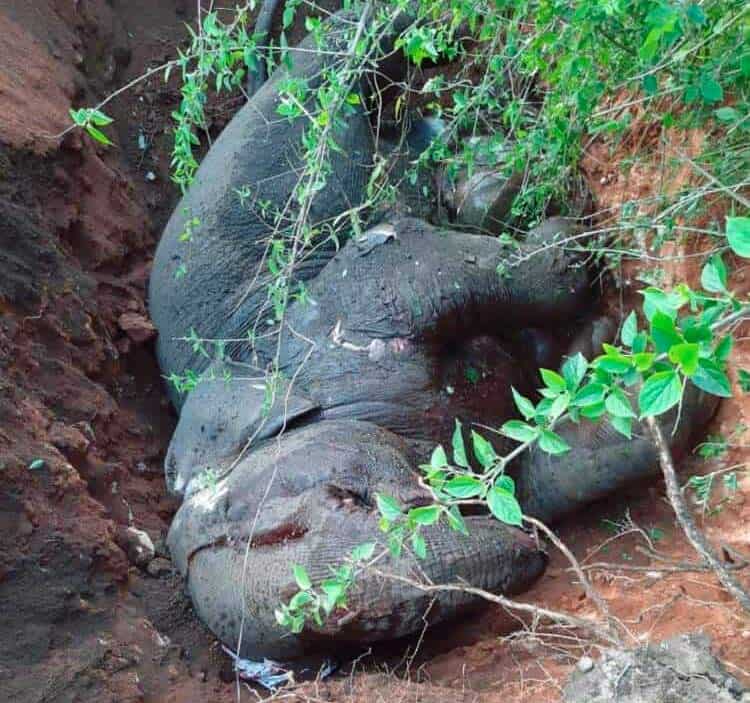
Dead elephant in Assam. Photo c/o Nava Thakuria.

